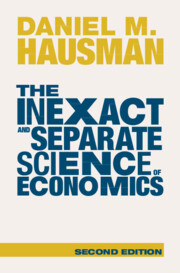Book contents
- The Inexact and Separate Science of Economics
- The Inexact and Separate Science of Economics
- Copyright page
- Contents
- Figures
- Tables
- Introduction
- Part I Introduction: Content, Structure, and Strategy of Mainstream Economics
- 1 Rationality, Preferences, and Utility Theory
- 2 Demand and Consumer Choice
- 3 The Theory of the Firm and General Equilibrium
- 4 Equilibrium Theory and Normative Economics
- 5 Equilibrium Theory and Macroeconomic Models
- 6 Models and Theories in Economics
- 7 The Structure and Strategy of Economics
- 8 Overlapping Generations
- Part II Theory Assessment
- Part III Conclusion
- Appendix An Introduction to Philosophy of Science
- References
- Index
5 - Equilibrium Theory and Macroeconomic Models
from Part I - Introduction: Content, Structure, and Strategy of Mainstream Economics
Published online by Cambridge University Press: 25 May 2023
- The Inexact and Separate Science of Economics
- The Inexact and Separate Science of Economics
- Copyright page
- Contents
- Figures
- Tables
- Introduction
- Part I Introduction: Content, Structure, and Strategy of Mainstream Economics
- 1 Rationality, Preferences, and Utility Theory
- 2 Demand and Consumer Choice
- 3 The Theory of the Firm and General Equilibrium
- 4 Equilibrium Theory and Normative Economics
- 5 Equilibrium Theory and Macroeconomic Models
- 6 Models and Theories in Economics
- 7 The Structure and Strategy of Economics
- 8 Overlapping Generations
- Part II Theory Assessment
- Part III Conclusion
- Appendix An Introduction to Philosophy of Science
- References
- Index
Summary
Chapter 5 provides a fragmentary introduction to macroeconomics that shows that highlights some of the philosophical questions macroeconomic models raise and relates them to equilibrium theory. Section 1 discusses how growth theory is linked to equilibrium theory. Section 2 considers how growth theory can be adapted to address questions about economic fluctuations, including recessions. Section 3 focuses on a simple influential Keynesian model of economic fluctuations. Section 4 discusses a specific relationship between employment and the rate of inflation (the Phillips Curve) that highlights methodological issues concerning causal inference and microfoundations that have led many economists to reject Keynesian economics. Section 5 develops these methodological issues further, highlighting the role of identities in macroeconomics.
Keywords
- Type
- Chapter
- Information
- The Inexact and Separate Science of Economics , pp. 125 - 153Publisher: Cambridge University PressPrint publication year: 2023

